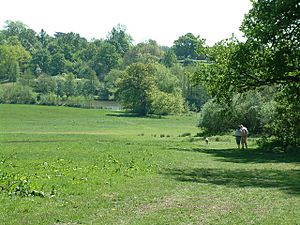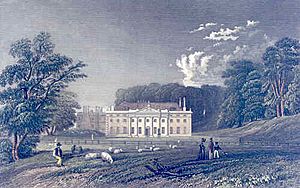Weald Country Park facts for kids
Weald Country Park is a large, historic park located in South Weald, near Brentwood in Essex, England. This amazing park is about 700 years old and covers 500 acres (2 square kilometers). It's a popular spot for families and nature lovers, managed by Essex County Council.
Contents
The Park's Long History
Weald Country Park has a fascinating past, stretching back centuries. The land, once known as Weald Manor, was bought by Sir Anthony Browne in 1547. He was an important judge at the time. Later, in 1685, Erasmus Smith became the owner.
How the Park Got Its Look
The beautiful design you see today is largely thanks to Hugh Smith, who owned the park from 1732 to 1745. He had the park landscaped in a natural style, similar to the famous garden designer Capability Brown. In 1752, Thomas Tower, a lawyer and Member of Parliament, bought the estate. His son, Christopher Tower, took over in 1778. He even hired a famous architect, Robert Adam, to design a new dining room for the house! The estate grew even larger under Christopher Thomas Tower, who owned it until 1867.
The Story of Weald Hall
Weald Hall was the grand house that stood in the park. By 1841, the estate was huge, covering 800 acres (3.2 square kilometers). In the 1800s, the hall was rented out to farmers. The estate was eventually divided up and sold in 1946. Sadly, Weald Hall was badly damaged during World War II and had to be taken down in 1950–51.
What Remains of the Hall
Even though the main house is gone, you can still find some parts of it. There are steps that once led to a "folly" – a decorative building in the park. A small 16th-century building, sometimes called "Queen Mary's Chapel," also remains. People used to say that Queen Mary I used it for quiet prayer. This building was once inside the walled kitchen garden of Weald Hall.
Olympic Dreams for the Park
Did you know Weald Country Park was almost an Olympic venue? It was chosen to host the mountain biking events for the 2012 Summer Olympics in London. However, after experts from the Union Cycliste Internationale visited, they decided the park wasn't challenging enough for international races. A new place was found at Hadleigh Country Park instead.
An Ancient Hill Fort
Weald Country Park is also home to an ancient site called South Weald Camp. This was a hillfort built by people in the late Iron Age, around 2,000 years ago. It was a circular fort, covering about 2.8 hectares (6.9 acres). People like the Catuvellauni and Trinovantes tribes might have lived here.
What the Fort Looked Like
The fort had strong defenses, including a large rampart (a raised bank) and a steep slope, with signs of a ditch outside. After the Iron Age, the fort was used as part of a deer park in medieval times. Later, it became a training ground during World War II. Today, a road called Sandpit Lane runs through the middle of the old fort. Part of it is in Weald Country Park, and the rest is owned by the South Weald Cricket Club.



